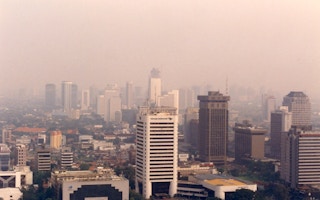When cities around the world went under lockdown this year to curb the spread of the coronavirus, smog-choked urbanites from Los Angeles to Delhi were offered a rare taste of clean air and views of snow-crested mountains usually enveloped in toxic haze.
To continue reading, subscribe to Eco‑Business.
There's something for everyone. We offer a range of subscription plans.
- Access our stories and receive our Insights Weekly newsletter with the free EB Member plan.
- Unlock unlimited access to our content and archive with EB Circle.
- Publish your content with EB Premium.
But not so in Jakarta. Although officials urged residents in the Indonesian capital to stay at home earlier this year, leading to a drop in business activity and traffic, the Suralaya power plants in the nearby province of Banten kept burning coal, and winds swept the lung-wrecking smoke into the city.
This contributed to the air in the bustling metropolis of 10 million people remaining laden with fine particulate matter (PM2.5), even after authorities introduced severe restrictions on public activities in March, reveals a new report by the Centre for Research on Energy and Clean Air (CREA), an independent research organisation.
From the day Indonesia implemented work-from-home and other anti-Covid-19 measures until the end of May, PM2.5 pollution in Jakarta reached “unhealthy” levels on seven days, with concentrations considered “unhealthy for sensitive groups” recorded on most other days.
A pollutant particularly harmful to human health, PM2.5 is small enough to penetrate deep into the lungs and cardiovascular system, causing diseases such as stroke, heart disease, lung cancer and respiratory infections.
In recent years, air pollution in Jakarta has worsened as more cars and motorbikes clog the roads and the city’s concrete jungle expands. But the new study indicates smog-stricken Jakartans also need to be worried about manufacturing facilities and power plants mushrooming far away from the metropolis.
Given the impact of emissions from factories and coal combustion outside the city on Jakarta’s air quality, controlling emissions from transportation will not be enough to address the capital’s deadly pollution problem, write the authors.
“Tackling air pollution anywhere really requires controlling emissions from various sources. Our findings in Jakarta indicate that tackling pollution from industries—especially heavy-polluting sectors like steel, cement and power plants—is an important and overlooked part of the equation,” said Isabella Suarez, analyst for Southeast Asia at CREA, and one of the authors of the report.
Pollutants can remain airborne for long periods of time and travel hundreds of kilometres, reaching the capital from the surrounding provinces of Banten, West Java and Tangerang and even as far as central Java. Emissions in these provinces have increased significantly over the past decade in the wake of growing fossil fuel use and industrial activity.
In Jakarta and within a 100-kilometre radius of its borders, there are 136 registered, high-emitting industrial facilities—including coal power plants, cement and steel, glass, oil and gas refining, and petrochemicals and plastics—belching out PM2.5, mercury, nitrogen oxide and sulphur dioxide. The worst pollution days in the capital have often coincided with winds passing through clusters of factories, where they pick up fumes and dust.
As well as costing Jakartans an estimated IDR 5.1 trillion (US$346 million) each year, transboundary pollution from coal combustion is responsible for some 2,500 premature deaths in the Jakarta Metropolitan Area annually, the study estimates.
PM2.5 monitoring in the metropolis recorded 101 days with “unhealthy” air quality in 2018 and 172 in 2019, with pollution levels frequently exceeding the recommended concentrations of the World Health Organization (WHO) three-fold. Nearly 60 per cent of Jakartans suffer from respiratory illnesses associated with filthy air.
Despite such impacts, the Indonesian government appears reluctant to wean itself off coal, which is the world’s dirtiest fossil fuel. The archipelago already has more coal plants in operation than any other nation in Southeast Asia, with its current generation capacity double that of 2010. But it has another 31.2 gigawatts of coal ventures in the pipeline.
Of the new projects, 20 per cent will be sited near Jakarta. Their impact on air quality will be equivalent to that of 10 million more cars unleashed within the city. If all plans go ahead, they could claim an additional 2,600 lives every year, stated the new study.
A report by air quality monitoring network IQAir AirVisual published earlier this year declared Jakarta the fifth-most polluted city globally, indicating the city had dethroned Beijing, the capital with the world’s dirtiest air just a few years ago.
Weary of breathing dangerous air, some 30 activists and environmentalists decided to file a lawsuit against the Indonesian government to take action in July last year. Although it first received a positive response, the lawsuit has been delayed multiple times and remains unresolved even after several meetings were held both inside and outside the courtroom.
Dirty air is a manageable problem. But keeping pollution in check requires better policies to regulate and monitor air quality and pollution sources, CREA’s Suarez told Eco-Business. Indonesia also needs stronger enforcement mechanisms to hold polluters both within and outside the city to account, ensuring factories are retrofitted to adhere to safer regulations. Finally, Indonesia must update its air quality standards, which currently permit PM2.5 levels more than double what the WHO deems safe, she said.












